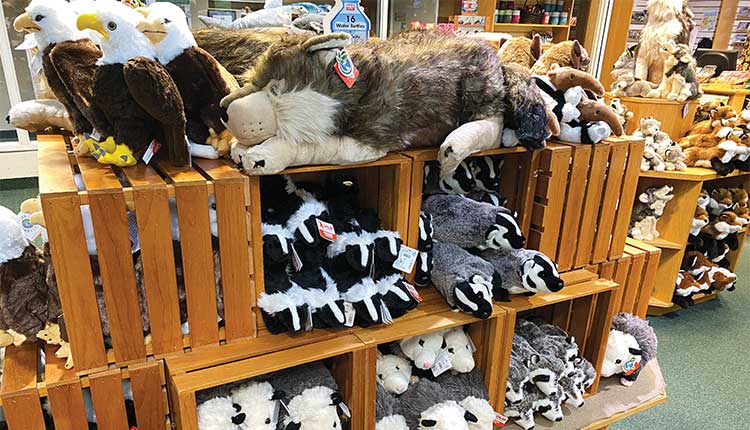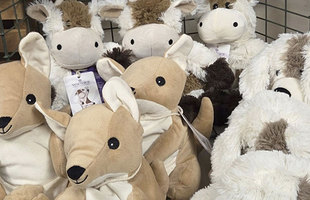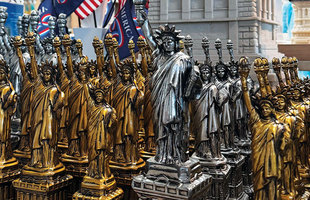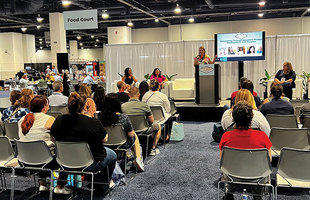A day at the zoo or a visit to a museum would not be complete without a trip to the gift shop, and for those destinations with animals as the main attraction, plush animals are big business.
While ZooMontana’s Wild Side Gift Shop carries zoo-branded apparel and souvenirs, books and hardline toys like games and puzzles, Kathy Barton, guest services manager, says the store also carries “plush, plush, plush!”
In fact, these cuddly, stuffed creatures make up 45 to 48% of gift shop sales. “Plush reigns supreme,” she says. Why? “Kids love to have something to cuddle on the way home that will remind them of the fun day they had at the zoo.”
In keeping with the zoo’s mission to educate and conserve, Barton restricts the plush styles she carries in the store to only the species that reside at ZooMontana and as close to lifelike as possible.
“You won’t find big-beaming-eyed red pandas or rainbow sloths here, but the customers don’t seem to mind,” she says. “They love that the brands we carry are dedicated to sustainability — like the Eco Pals or Plan lines by Nature Planet. Aurora, Wild Republic and The Petting Zoo round out the rest of our selection.”
Plush is front and center in the store no matter which way customers enter. The large central display was made from recycled electrical wire spools, stacked and fitted with shelves, cubbies and baskets.
“It totally fits Montana’s barnwood vibes and allows us to build a visually engaging vertical display on a relatively small footprint,” Barton explains.
Tiny trends
And Barton is noticing some interesting trends this year with plush. “Things are shrinking. More and more shoppers are buying those tiny plush, and vendors are adding more and more species to their tiny plush lines.”
Wild Side Gift Shop carries small 5- to 6-inch pieces like Wild Republic’s Pocketkins, which Barton says are consistently at the top of the store’s list of bestsellers. “At $6.45, it’s the perfect price point for many shoppers.”
The animals that tend to fly out the door the most are the sloth, red panda, tiger, wolf and snake. And because plush is so popular, outselling hardline toys by 4 to 1, Barton is even considering offering promos to shift some of the slower moving or overstocked toys. “For example, 50% off plush when you buy a puzzle.”
Dinosaurs deliver
At the Virginia Living Museum where more than 250 species of animals native to the state reside, the Wild Things Gift Store is busting at the seams with plush of just about any style, animal and size one could want.
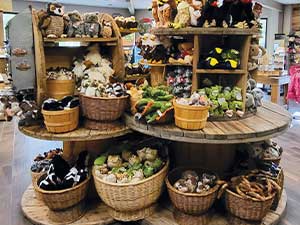
ZooMontana displays plush on recycled electrical wire spools, stacked and fitted with shelves, cubbies and baskets.
The venue features mammals, marine life, reptiles, amphibians, birds, plants and planets presented in natural ecosystems that connect people to nature through educational experiences that promote conservation. While dinosaurs are long extinct, the museum also pays homage to them with activities, including a summer animatronic dinosaur exhibit and a Dino Trail where kids can go on pretend digs for fossils.
“They are always a big hit,” says Stacy Queensberry, Wild Things Gift Store buyer, of dinosaurs.
She says gift shop customers are drawn to their favorite animal or dinosaur plush, with dinosaurs and snakes taking the No. 1 and No. 2 spot in terms of popularity. And unlike ZooMontana, not all the plush varieties are replicas of the animals living at the museum.
“I’ve got pink snakes. I’ve got purple snakes. I’ve got polka-dotted sequined snakes. Snakes sell all because of color,” says Queensberry. Plush makes up 42% of the store’s annual sales.
Price point matters
She also says price-point plays a factor. “My average price point on a sale per month is about $20 to $22 dollars. Yes I have some $100 plushies. Yes I have some $2.99 plushies, but the $20 to $22 price point is a happy price point I think for most people.”
In addition to dinos and snakes, foxes, wolves and otters are also popular in the plush category. The otter is Virginia Living Museum’s mascot and is even incorporated into its logo. Queensberry notes that she can’t just carry one plain otter, she has to have a mom and baby otter, a standing otter, an 8-inch otter, a 6-inch otter, an 18-inch otter and so forth.
A large tree is the focal point display visitors see when they enter the store. Queensberry says she tries to change out the displays every month depending on events and exhibits that are taking place at the museum. “It always has a plush in front of it and then behind the tree I have a large, 10-foot-long table that has crates stacked on top of that.”
Themes and preferences
Throughout the store she has dedicated areas to plush themes, including one featuring sea life and another on butterflies and bees. There is also a display of just otters and one of foxes and bobcats.
Aside from the animal species, eco-friendliness is an important factor in the plush Virginia Living Museum carries. Queensberry says the store is focused on making sure the eyes are either sewn in or made from recycled plastics.
“I never thought in a million years someone would come
in and buy a $105, 69-inch alligator, but it sold in the first week. Needless to say, I bought two more.” — Stacy Queensberry, The Virginia Living Museum
Wild Republic, Douglas and Rhode Island Novelty are among the top brands Queensberry keeps stocked. And customers are drawn to different brands for different reasons such as how realistic they are, how soft they are or price point.
The top demographic for plush tends to be the children ages 5 to 8 years old, but Queensberry notes that teenagers and even young adults “love opossums and other odd animals.” They like the way opossum’s tail curls up, or the color of the frogs or the realistic look of the snapping turtle.
“The snapping turtle has been a huge hit lately, and I didn’t think it would do very well because it is a $32 price point and it is a sublimation print, not fur, but the realistic look of it catches a lot of people,” she notes.
Queensberry was also surprised when a 69-inch alligator she purchased for a display sold in short order.
“I never thought in a million years someone would come in and buy a $105, 69-inch alligator, but it sold in the first week. Needless to say, I bought two more.”
Queensberry says she strives to keep things fresh inside the store for museum members that come in frequently. The store is also open to the public who can shop regardless of whether they paid to visit the museum, making it a place where people come to buy unique gifts that often include an interesting plush toy or two.
